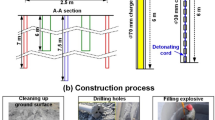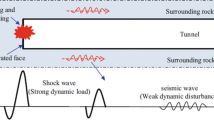Abstract
The friction pendulum bearing (FPB) has been widely studied as an effective dry friction sliding isolation device, due to its self-limit and self-reset capability. The refinement finite element models of FPB were applied to column supporting single-layer reticulated domes. The seismic performances of these structures with FPBs were systematically analyzed by finite element software LS-DYNA. Numerical results illustrate that the optimal friction coefficient of FPB increases with increasing earthquake intensity and the optimal range of friction coefficient locates between 0.025 and 0.15. The seismic effects of single-layer reticulated domes with FPBs are strengthened with the increase of curvature radius, while isolation effect of FPBs has no obvious change as the curvature radius exceeds 1.5 m. Additionally, the parameter selection principles of friction pendulum bearings for column supporting single-layer reticulated domes are given by means of investigating the force of the slider of FPBs and dynamic analysis of single-layer reticulated domes with FPBs.
Similar content being viewed by others
References
Al-Hussaini, T. M., Constantinou, M. C., and Zayas, V. A. (1995). “Superstructure response of sliding-isolated multi-story frame structure.” Proceedings of the 1995 Joint ASME/JSME Pressure Vessels and Piping Conference, July 23-27, Honolulu, HI,USA.
Caliò, I., Marletta, M. and Francesco, V. (2003). “Seismic response of multi-storey buildings base-isolated by friction devices with restoring properties.” Computers and Structures, 81, pp. 2589–2599.
Cardone, D., Dolce, M. and Gesualdi, G. (2009). “Lateral force distributions for the linear static analysis of baseisolated buildings.” Bull Earthquake Engineering, 7, pp. 801–834.
Dicleli, M. (2002). “Seismic design of life-line bridge using hybrid seismic isolation.” Journal of Bridge Engineering, ASCE, 7(2), pp. 94–103.
Dicleli, M., Albhaisi, S. and Mansour, M. Y. (2005). “Static soil-structure interaction effects in seismic-isolated bridges.” Practice Periodical on Structural Design and Construction, ASCE, 10(1). pp.22–33.
Dicleli, M. and Mansour, M. (2003). “Seismic retrofitting of highway bridges in Illinois using friction pendulum seismic isolation bearings and modeling procedures.” Engineering Structures, 25(9), pp. 1139–1156.
Earthquake Protection Systems (2016). “Technical characteristics of friction pendulum bearings. http://www.earthquake protection.com/TechnicalCharacteristicsofFPBearngs.pdf.
Eröz, M. and DesRoches, R. (2008). “Bridge seismic response as a function of the Friction Pendulum System (FPS) modeling assumptions.” Earthquake Engineering Structures, 30, pp. 3204–3212.
Ersoy, S., Saadeghvaziri, M., Liu, K. and Mau, S. T. (2001). “Analytical and experimental evaluation of friction pendulum system for seismic isolation of transformers.” Earthquake Spectra, Journal of Earthquake Engineering Research Institute, 17(4), pp. 569–595.
Fan, F., Kong, D. W., Sun, M. H. and Zhi, X. D. (2014). Anti-seismic effect of lattice grid structure with friction pendulum bearings under the earthquake impact of various dimensions. International Journal of Steel Structures, 14(4), pp. 777–784.
GB 50011 (2010). Code for seismic design of buildings. China Architecture & Building Press, Beijing (in Chinese).
Jangid, R. S. (2008). “Stochastic response of bridges seismically isolated by friction pendulum system.” Journal of Bridge Engineering, 13(4), pp. 319–330.
JGJ 7 (2010). Technical specification for space frame structures. China Architecture & Building Press, Beijing (in Chinese).
Kong, D. W., Fan, F. and Zhi, X. D. (2014). Seismic response analysis of single layer lattice shell with FPBs. International Journal of Steel Structures, 14(4), pp. 901–911.
Kong, D. W., Sun, M. H., Zhi, X. D. and Fan, F. (2012). Seismic performance of single-layer lattice shells with VF-FPB. China Civil Engineering Journal, 45, S1, pp. 158–162 (in Chinese).
Mokha, A, Amin, N, Reinborn, M. A., and Zayas, V. A. (1996). “Seismic isolation retroÞt of large historic buildings. Journal of Structural Engineering. 122, pp. 298–308.
Mokha, A, Constantinou, M. C., Reinborn, M. A., and Zayas, V. A. (1991). “Experimental study of frictionpendulum isolator system. Journal of Structural Engineering. 117(4), pp. 1201–1217.
Mokha, A. S., Lee, P. L., Wang, X. F. and Yu, P. (1999). “Seismic isolation design of the new international terminal at San Francisco international airport.” Proceedings of the 1999 Structures Congress Structural Engineering in the 21st Century, April 18-21, New Orleans, LA, USA, pp. 95–98.
Mokha, A. S., Zayas, V. A. and Velivasakis, E. E. (2001). “Final design implementation of upgrade.” 2001 Structures Congress and Exposition, Structures 2001, May 21-23, Washington, DC, United States.
Tsai, C. S. (1997). Finite element formulations for friction pendulum seismic isolation bearings. International Journal for Numerical Methods in Engineering, 40, pp. 29–49.
Tsopelas, P. and Constantinou, M. C. (1996). “Experimental study of FPS system in bridge seismic isolation.” Earthquake Engineering and Structural Dynamics. 25, pp. 65–78.
Wang, Y. P., Chung, L. L., and Liao, W. H. (1998). “Seismic response analysis of bridges isolated with friction pendulum bearings. Earthquake Engineering and Structural Dynamics, 27, pp. 1069–1093.
Wongprasert, N. and Symans, M. D. (2005). “Numerical evaluation of adaptive base-isolated structures subjected to earthquake ground motions.” Journal Engineering Mechanics, ASCE, 131(2), pp. 109–119.
Yu, Z. W. (2007). “Vibration-reduction of single-layer reticulated domes with vibration reducing bearings.” Master Degree Thesis of Harbin Institute of Technology (in Chinese).
Zayas, V. S. and Low, S. S. (1995). “Application of seismic isolation to industrial tanks.” American Society of Mechanical Engineers, Pressure Vessels and Piping Division PVP, ASME, 319, pp. 273–288.
Zayas, V. A., Low, S. S., and Mahin, S. A. (1987). “The FPS earthquake resisting system. Technical Report UCB/EERC -87/01, University of California at Berkeley.
Zayas, V. A., Low, S. S., and Mahin, S. A. (1990). “A simple pendulum technique for achieving seismic isolation. Earthquake Spectra, 3, pp. 317–334.
Author information
Authors and Affiliations
Corresponding author
Rights and permissions
About this article
Cite this article
Kong, D., Wang, L., Fan, F. et al. Seismic performance of column supporting single-layer reticulated domes with friction pendulum bearings. Int J Steel Struct 17, 471–480 (2017). https://doi.org/10.1007/s13296-017-6007-7
Received:
Accepted:
Published:
Issue Date:
DOI: https://doi.org/10.1007/s13296-017-6007-7




